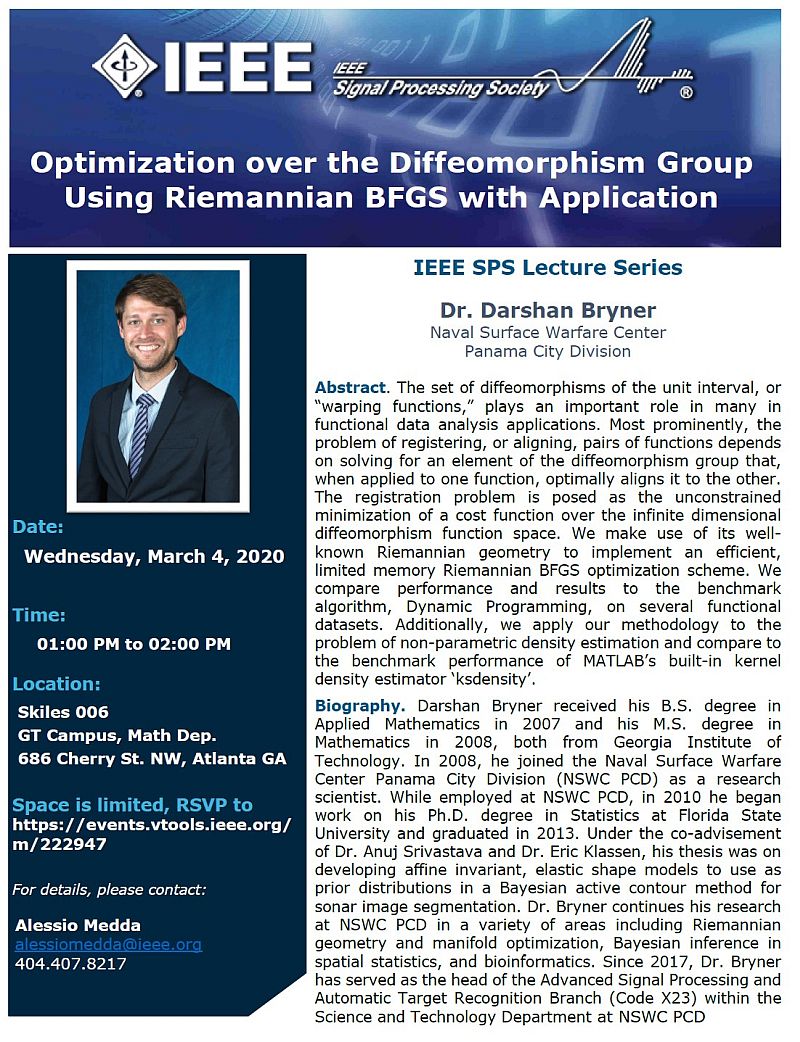Optimization over the Diffeomorphism Group Using Riemannian BFGS with Application

The Atlanta Signal Processing Chapter is honored to host Dr. Darshan Bryner, Research Scientist at the Naval Surface Warfare Center Panama City Division (NSWC PCD)
Dr. Bryner will present a lecture titled "Optimization over the Diffeomorphism Group Using Riemannian BFGS with Application."
Dr. Bryner research interests include Riemannian geometry and manifold optimization, Bayesian inference in spatial statistics, and bioinformatics.
Since 2017, Dr. Bryner has served as the head of the Advanced Signal Processing and Automatic Target Recognition Branch (Code X23) within the Science and Technology Department at NSWC PCD.
Date and Time
Location
Hosts
Registration
-
 Add Event to Calendar
Add Event to Calendar
Speakers
Darshan Bryner
Optimization over the Diffeomorphism Group Using Riemannian BFGS with Application
The set of diffeomorphisms of the unit interval, or “warping functions,” plays an important role in many in functional data analysis applications. Most prominently, the problem of registering, or aligning, pairs of functions depends on solving for an element of the diffeomorphism group that, when applied to one function, optimally aligns it to the other. The registration problem is posed as the unconstrained minimization of a cost function over the infinite dimensional diffeomorphism function space. We make use of its well-known Riemannian geometry – the positive orthant of the unit Hilbert sphere under the L2 metric – to implement an efficient, limited memory Riemannian BFGS optimization scheme. We compare performance and results to the benchmark algorithm, Dynamic Programming, on several functional datasets. Additionally, we apply our methodology to the problem of non-parametric density estimation and compare to the benchmark performance of MATLAB’s built-in kernel density estimator ‘ksdensity’.
Biography:
Darshan Bryner received his B.S. degree in Applied Mathematics in 2007 and his M.S. degree in Mathematics in 2008, both from Georgia Institute of Technology. In 2008, he joined the Naval Surface Warfare Center Panama City Division (NSWC PCD) as a research scientist. While employed at NSWC PCD, in 2010 he began work on his Ph.D. degree in Statistics at Florida State University and graduated in 2013. Under the co-advisement of Dr. Anuj Srivastava and Dr. Eric Klassen, his thesis was on developing affine invariant, elastic shape models to use as prior distributions in a Bayesian active contour method for sonar image segmentation. Dr. Bryner continues his research at NSWC PCD in a variety of areas including Riemannian geometry and manifold optimization, Bayesian inference in spatial statistics, and bioinformatics. Since 2017, Dr. Bryner has served as the head of the Advanced Signal Processing and Automatic Target Recognition Branch (Code X23) within the Science and Technology Department at NSWC PCD.
Address:United States
Agenda
- 01:00 PM - 01:10 PM - Introductions
- 01:10 PM - 02:00 PM - Lecture
- 02:00 PM - 02:30 PM - Reception and networking

